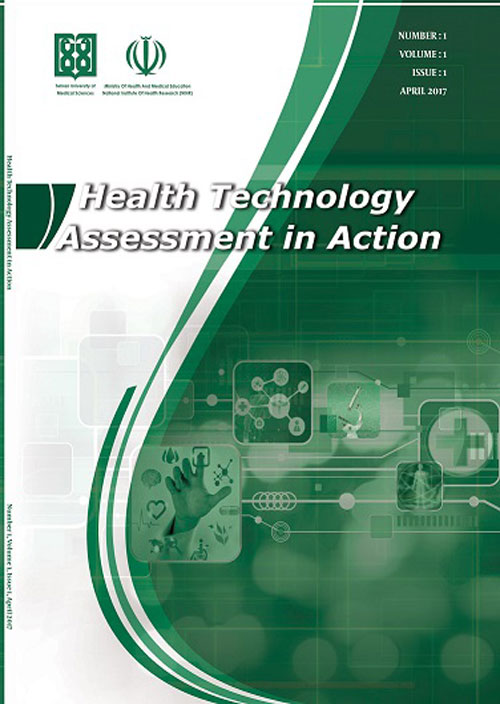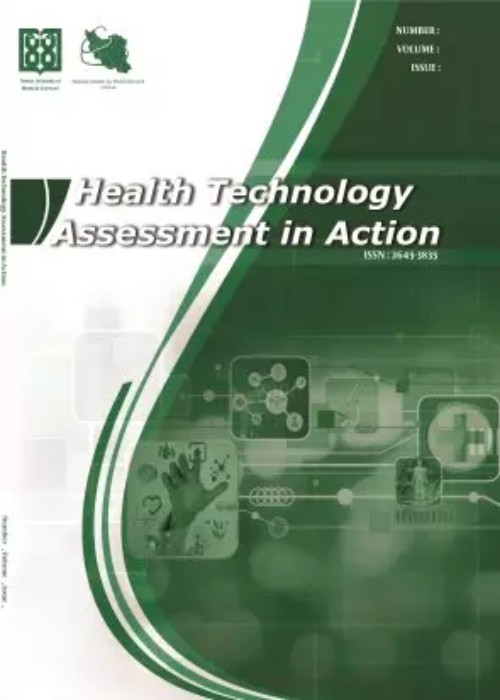فهرست مطالب

Health Technology Assessment in Action
Volume:4 Issue: 2, Nov 2020
- تاریخ انتشار: 1400/01/24
- تعداد عناوین: 6
-
-
Page 1Context
Nowadays, due to the increased publication of articles in various scientific fields, identifying the publishing trend and emerging keywords in the texts of these articles is essential. Thus, the present study has identified and analyzed the keywords used in published articles on medical librarianship and information.
Materials and MethodsIn the present investigation, an exploratory and descriptive approach has been used to analyze librarianship and information articles published in specialized journals in this field from 1964 to 2019 by applying text mining techniques. The TF-IDF weighting algorithm has been applied to identify the most important keywords used in the articles. Python programming language has also been used to implement text mining algorithms.
ResultsThe results obtained from the TF-IDF algorithm indicate that the words “library”, “patient”, and “inform” with the weights of 95.087, 65.796, and 63.386, respectively, were the most important keywords in the published articles on medical librarianship and information. Also, the words “Catalog”, “Book” and “Journal” were the most important keywords used in the articles published between the years 1960 and 1970, and the words “Patient”, “Bookstore” and “Intervent” were the most important keyword used in articles on medical librarianship and information published from 2015 to 2020. The words “Blockchain”, “telerehabilit”, “Instagram”, “WeChat”, and “comic” are new keywords observed in articles on medical librarianship and information between 2015 and 2020.
ConclusionThe results of the present study have revealed that the keywords used in articles on medical librarianship and information have not been consistent over time and have undergone an alteration at different periods so that nowadays, this field of science has also changed following the needs of society with the advent and growth of information technologies.
Keywords: librarianship, information, Medical, Analysis, Text mining -
Page 2Objectives
The Iran’s Health Technology Assessment (HTA) System has been established since 2008. The purpose of this study is to define the future steps needed to promote HTA in Iran by considering possible future events related to health secotor .
MethodsA preliminary list of future trends potentially effective on Iran's HTA system was extracted through literature review. These trends were presented to 12 experts and their opinions on the trends and then impact on the future of HTA of Iran were asked through in-depth interviews. The interviews were analyzed using thematic analysis method from two dimensions; firstly, in three categories of capacity building, provision of HTA and supportive mechanisms and secondly according to the critical functions of a health system (i.e. control knobs).
ResultsThe study subjects think that the strengthening HTA system is a must in both scenarios of international sanction’s continuation and its lifting. In the category of capacity building, alignment trainings to the needs, using the capacity of graduates in conducting HTAs, increasing number of students’ admission, establishment of a PhD program, turning HTA into a public demand and prevent the overuse of medical technologies were elaborated. In the second category which was provision of HTA the following themes were introduced: modernization and equipping health system infrastructure based on the HTA, legitimating HTA for using all health technologies, preventing the introduction of not necessary technologies and technologies that have similar once produced in Iran and imposition HTA in determining of the basic benefit package in across the country.
ConclusionsIran’s is an untapped market due to the economic sanction. If sanction continues, then HTA will be a serious need for resilience of the health system. However, if the sanction be lifted, then it will be needed more on optimizing health system resources for benefiting the population health of Iranians. These steps, in both scenarios, are mostly on institutionalization of HTA which mostly on legitimation and behavioral changes.
Keywords: HTA, sanction, Iran -
Page 3
Heaelth technology assessment perform important role in health system decision making. Most of countries with the use of result of assessment in health systems decision making contribute to improve of efficiency allocative in their health systems.
-
Page 4
For providing quality health care proper management of medical equipments is important. A computerized maintenance management system (CMMS) is a software package used by healthcare technology management (HTM) programs as a tool to manage, organize, collect, store, analyze, and report data on medical technology in a healthcare facilities. Though, CMMS are introduced as a beneficial and flexible tool for transforming the management of biomedical equipment but no evidence of same has been documented yet to highlight the efficacy of CMMS in Indian context. CMMS, an e-Health system used by HTM programs, is a relative new technology being adapted by various states of India. It is very important to assess whether this system is functioning and producing the effects as expected. Assessment will inform decision makers about what is known and what is not known about the technology and will provide an in-depth understanding of the strengths and weaknesses of this technology. Health Technology Assessment (HTA) is a formal, systematic research process designed to synthesize and evaluate the existing evidence for a medical treatment or health delivery innovation. So considering HTA perspective, an assessment approach to CMMS could be planned. Systematic reviews and empirical frameworks that have been used to make sense of e-Health systems and their evaluation could be used for assessment of this technology. Assessment of CMMS from HTA perspective should be integral to the adoption of HTM systems by healthcare organizations.
Keywords: HTA, CMMS, Medical Equipment, e-Health, Healthcare Sector -
Page 5
The aim of this systematic review and meta-analysis is to investigate the diagnostic accuracy of Computed Tomography Angiography (CTA) in comparison with that of Single-photon emission computed tomography (SPECT) for the diagnosis of Coronary Artery Disease (CAD) in patients with chest pain who have no prior history of cardiovascular diseases Invasive coronary angiography was considered as the reference test.
MethodCochrane, Scopus, Science Direct, Pubmed and Embase databases were searched. Meta-analysis was performed for determination of pooling estimates of sensitivity, specificity and positive and negative likelihood ratios in CTA and SPECT tests.
ResultsThe pooled sensitivity and specificity of CTA were 91% (95% Confidence Interval [CI] 88%-94%) and 87% (95% CI 84%-98%), respectively. The pooled positive and negative likelihood ratios and the area under the Receiver Operating Characteristic (ROC) curve for CTA were 7.93 (95% CI 5.11-12.29), 0.1 (95% CI 0.06-0.17) and 0.96, respectively. The pooled sensitivity and specificity of SPECT were 81% (95% CI 79%-83%) and 74% (95% CI 71%-78%), respectively. The pooled positive and negative likelihood ratio sand the area under the ROC curve for SPECT were 3.03 (95% CI 2.34-3.91), 0.25 (95% CI 0.21-0.30) and 0.86, respectively.
ConclusionsAccording to the results, the diagnostic accuracy of CTA and SPECT tests lie in the excellent and the very good ranges, respectively. CTA is a stronger evidence than SPECT to rule out cardiovascular diseases in patients with low to intermediate risks for CAD who had no prior history of cardiovascular diseases.
Keywords: Coronary Artery Disease, Computed Tomography, Angiography, Single-photon emission computed, tomography (SPECT), sensitivity, specificity -
Page 6Introduction
Regular performance assessment is the basis of effective managerial decision making which is crucial for increasing the productivity of an organization. A distinct characteristic of an effective performance assessment is the implementation of various methods which are aimed at assessing the conformity with multiple indicators and criteria. The aim of the present comprehensive review was to extract the factors affecting the performance assessment of organization.
MethodsWe conducted a comprehensive search in databases including PubMed, Embase, SID and Magiran in January 2020. Inclusion criteria were articles with the English language and full text available that were about influential factors. Two independent reviewers checked the research process, screening of articles.
ResultsFactors influencing an effective and efficient organizational performance assessment categorized in three themes and 22 sub-themes emerged. The themes included: “performance assessment indicators”, “performance assessment criteria” and “background factors in performance assessment”.
ConclusionIndicators, criteria, and background factors provide a framework for assessing the organization's overall performance. An organization can manage its human resources effectively and efficiently by considering all the effective factors. Identification and classification of influential factors can be of help for managers and decision-makers in creating performance assessment system.
Keywords: Work Performance, Assessment, Measurement, Organizations, Occupational Groups


